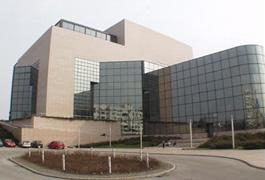Presenting / Institutions / National and University Library in Zagreb
National and University Library in Zagreb

The National and University Library in Zagreb is a public institution of national importance, engaged in library and information activity as the national library of the Republic of Croatia and the central library of the University of Zagreb.
History of the Library
The history of the guardian of Croatian literacy - the National and University Library - includes many memorable dates. However, during its continuous activity spanning almost four centuries some of them deserve to be singled out as milestones.
The inception of this treasury of knowledge dates back to 1607 when the Jesuits established their residence and founded a grammar school in Zagreb's Upper Town, followed by their college in 1611.
Records about the first books in the library holdings date from the same year. Already by 1645 the Library had its own hall, a librarian, and rules on book preservation and lending.
As a course in philosophy was added to the grammar school, Emperor Leopold granted the institution the title of Academia Zagrabiensis by a charter in 1699.
Its first domicile was the old building of the abandoned Benedictine monastery on present-day Katarinski trg 5. After the abolition of the Jesuit order in 1773, the college operated on an interim basis until 1776, when the Library became part of the Royal Zagreb Academy of Science (Regia Academia Zagrabiensis), a school of higher learning of law, philosophy and theology. In 1777 the holdings of the Library increased owing to a large bequest of historic records donated by Dean Adam Baltazar Krčelić. In his deed of donation the Dean requested that the books should be made available to the general public.
The national importance of the Library began officially with the enforcement of the compulsory copy law (1816 and 1837). In 1837 Antun Kukuljević gave it a Latin name - Nationalis Academica Bibliotheca - highlighting its dual functions (of an educational and national library), still expressed in its current name.
In 1816 the Library acquired the right to a free copy of publications printed by the University of Pest, and after 1837 to a free copy of all publications printed throughout Croatia and Slavonia.
After the foundation of the University of Joseph Francis I in 1874, the Academy Library (Bibliotheca Regiae Academiae Zagrabiensis) became the University Library. As an integral part of the University the Library became an even more important part of higher learning.
The location of the Library changed again in 1913. With its 110,volumes it moved from the present-day university administration building to the impressive Secession edifice on Trg (Square) Marka Marulića 21, the first structure that was built specifically for the need of the Library. Designed for holdings totalling 500,000 volumes, the building soon became too small for the Library’s 2,500,000 books, journals, newspapers and particularly valuable collections.
After several years spent on preparations academicians Andro Mohorovičić and Ivan Jurković laid the cornerstone for the new building of the National and University Library on 5 May 1988. In spite of many difficulties, and the war imposed on it , the Republic of Croatia succeeded in completing the planned part of the building - the symbol of Croatian national cultural memory.
The temple of the Croatian book was solemnly opened on 28 May 1995 during the celebration of the fifth anniversary of Croatia’s Independence Day.
The National and University Library collects and preserves the written and printed cultural heritage of Croatia by relying primarily on the compulsory copy used for preparing the Croatian bibliography. The Library pursues its role as the national library of the Croats by acquiring library material authored by Croats (regardless of the place of publication or of its language), material written in Croatian (regardless of its place of publication/printing and nationality of the author), and foreign literature on Croatia and the Croats.